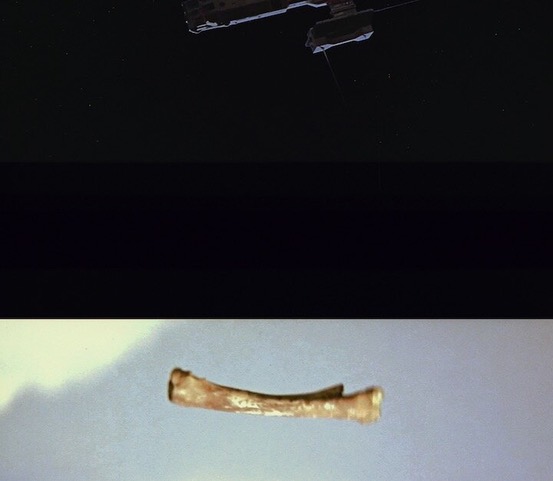
Josh Azzarella, Untitled #275 (Return of the Son of Nothing), 2019, dye sublimation print, 48 x 55.25 inches

Josh Azzarella, Untitled #275 (Return of the Son of Nothing), 2019, dye sublimation print, 48 x 55.25 inches
Because of the COVID-19 pandemic, Tiffany Calvert’s and Josh Azzarella’s show S/AMPLE DATA at Tinney Contemporary in Nashville, Tennessee, was shuttered soon after it opened: bad timing you might say, it was tough luck to draw this particular time slot. But after looking at the work and talking with the artists I now doubt that these bromides take a broad enough perspective. Calvert and Azzarella use current technology to make multidisciplinary responses to art of the past; Calvert paints on top of large-scale prints of Dutch Master still life paintings that she alters with software, and Azzarella digitally mines and manipulates Stanley Kubrick’s 2001: A Space Odyssey. Viewing the work during the quarantine mirrors personal isolation and an altered perception of time. The unsettled, often empty, extended vacation we’ll recall as the spring of 2020 feels like one of the gaps or breaches that dominate the S/AMPLE DATA aesthetic. Stressing the shortcomings that arise in transmitting and translating data while copying an art history source, the show establishes code as content, and limits the human presence to mechanical parameters, hiccups, and glitches.
Azzarella’s dye sublimation print Untitled #275 (Return of the Son of Nothing) spotlights the jump cut between an ape-tossed bone leaving and a spaceship entering the frame near the start of Kubrick’s film: one twenty-fourth of a second condenses the passage of eons and the rise of mankind through pairing these two images. Azzarella turns our attention to the gap between the two images, the seam between an ape’s gesture and the promise of an outer space adventure, enclosing Kubrick’s extreme compression of events and his sudden, colossal shift in scale. When discussing this piece, Azzarella related the two images to memory and anticipation, paraphrasing Carlo Rovelli’s idea that “humans experience time between memory and anticipation.” This may explain why not knowing when it will be safe to go back to work, travel or join large groups of people might be more isolating than feeling lonely today. As we are conforming to the virus’s timetable, constricting our own activities and feeling adrift, it is time that seems stalled as memories gradually uncouple from anticipation.
Like Azarella’s Untitled #275, Calvert’s paintings savor the breach between past and future and expose rather than smooth over transitions between the Dutch Master copy and her oil paint application. Her finished paintings flaunt raised edges of slabs of paint, cracks, crevices and other incongruent transitions between the old and new. She uses software to alter, grid, fragment or otherwise “glitch” the Dutch Master image before making a digital print. After designing and applying full-sized vinyl masks to the print, she paints on top of the exposed areas, which involves chance, since she cannot see exactly what is preserved and what is obscured until she removes the mask. The masking and painting steps must take place within a day, because the paint starts to dry and removing the mask can lift her paint work. Sometimes slivers of mask are left on the surface. The mask allows her to respond indirectly and imperfectly to the Dutch Master’s brushstrokes. Filtering Seventeenth-century nature through code supresses but does not entirely overrule appreciating the beauty of flowers.
In Calvert’s paintings #331 and #335 abrupt junctions between past and future balloon into empty, dark masked shapes. Whole sections of the painting are obscured and emptied of content, leaving restful zones where neither Calvert nor a Dutch Master hold sway: she occupies the same amount of square footage but sacrifices volumes of information. Conversely, Azzarella’s video and audio piece, Untitled #177 (Roesch and Schlage), breaks the standard image plane, allowing an algorithm to sort beyond the source size into a much larger canvas. While working with the exact same amount of data, Azzarella processes and rebuilds images in an unrestricted way. His video breaks out of the rectangular aspect ratio of Kubrick’s film, in contrast to Calvert’s conservation of a domain that eliminates circumscribed information.
Memory is central to S/AMPLE DATA, both artists do not over-process or tweak to the extent that the original loses its integrity: both leverage the viewer’s ability to recall important qualities of these iconic paintings and films. Also, S/AMPLE DATA retains the elusiveness and abstraction of anticipation, the other half of Rovelli’s formula describing time. Azzarella’s Untitled #176 Albedo 0.343levitates a tiny monolith under the balanced effect of different magnets, an homage to Kubrick’s most mysterious presence in 2001. Azzarella’s response to the monolith intrigues because “it is doing both something and nothing. . . . I believe the ‘work’ of the piece is the liminal space between object and base. It might only be half an inch, but it is full of possibilities. The monolith continues to evolve, enlighten and withhold.” Calvert’s #350, a buon fresco foam sculpture carved by a CNC router, resembles a Victorian architectural detail that manifests yearning or sustained anticipation as a turned form.
So yes, it’s a bummer to have a show fall through the cracks during a pandemic; yet, it’s a great moment to ponder how the mutability of data affects the plasticity of time.
["S/AMPLE: Tiffany Calvert and Josh Azzarella" ran March 7 - April 13, 2020 at Tinney Contemporary in Nashville.]
[About the author: Elizabeth Johnson is an artist and writer.]